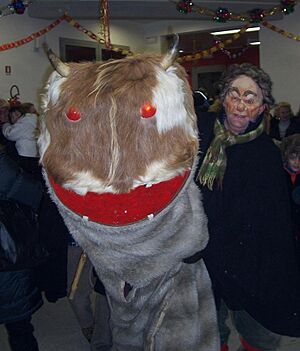Badalisc facts for kids
The Badalisc (also called Badalisk) is a mythical creature from the Val Camonica area in Italy. This region is located in the southern central Alps. People imagine the Badalisc as a creature with a large head. It's covered in goat skin and has two small horns. It also has a huge mouth and eyes that glow.
Contents
What is the Badalisc Celebration?
The Badalisc is part of a special tradition in the village of Andrista. This village is near Cevo. According to old stories, the Badalisc lives in the woods around the village. It's said to cause trouble for the people there.
Capturing the Creature
Every year, around Epiphany (January 5th and 6th), the Badalisc is "captured." Villagers lead it on a rope into the village. Musicians play, and people wear masks. These characters include "the young man," "the old man," "the old woman," and a young "lady." There are also drummers and shepherds with beards. A "hunchback" character even has a playful "duel" with the creature.
The Badalisc's Speech
Once the Badalisc is in the village square, a special event happens. It's called the "Badalisc's speech" (or la 'ntifunada). The Badalisc itself cannot speak. So, an "interpreter" reads a speech for it. This speech is now written in rhyme. It playfully talks about all the "sins" and secrets of the community. During the speech, the hunchback character bangs his stick to a rhythm.
Feasting and Fun
After the speech, everyone enjoys singing, dancing, and a big feast. In the evening, the community eats "Badalisc polenta." This is a traditional food made from cornmeal. In the past, children would go from house to house. They would ask for cornmeal to make this polenta. A special Badalisc salami was also made for them. The Badalisc creature even gets a special spot at these feasts.
Returning to the Woods
On the second day of the celebration, the Badalisc is set free. It is allowed to go back to the woods. This marks the end of the yearly event.
Related Traditions
The Badalisc celebration is similar to other old traditions. One example is the Bosinada. These were satirical performances where a storyteller would talk about community misdeeds. They were common in northern Italy and came from old New Year's Eve rituals.
Gallery
See also





